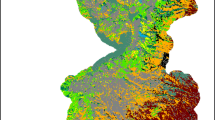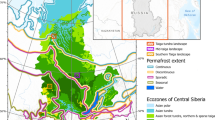Abstract
The generalization that plant communities increase in flammability as they age and invariably lead to resilient self-organized landscape mosaics is being increasingly challenged. Plant communities often exhibit rapidly saturating or even hump-shaped age-flammability trajectories and landscapes often display strong non-linear behaviors, abrupt shifts, and self-reinforcing alternative community states. This plethora of fire-landscape interactions calls for a more general model that considers alternative age-flammability rules. We simulated landscape dynamics assuming communities that (1) increase in flammability with age and (2) gain flammability up to a certain age followed by a slight and moderate loss to a constant value. Simulations were run under combinations of ignition frequency and interannual climatic variability. Age-increasing fire probability promoted high resilience to changes in ignition frequency and climatic variability whereas humpbacked-shaped age-flammability led to strong non-linear behaviors. Moderate (20%) reductions in mature compared to peak flammability produced the least resilient behaviors. The relatively non-flammable mature forest matrix intersected by young flammable patches is prone to break up and disintegrate with slight increases in ignition/climate variability causing large-scale shifts in the fire regime because large fires were able to sweep through the more continuous young/flammable landscape. Contrary to the dominant perception, fire suppression in landscapes with positive feedbacks may effectively reduce fire occurrence by allowing less flammable later stage communities composed of longer lived, obligate seeders to replace earlier stages of light demanding, often more flammable resprouters. Conversely, increases in anthropogenic ignitions, a common global trend of many forested regions may, in synergism with increased climate variability, induce abrupt shifts, and large-scale forest degradation.






Similar content being viewed by others
REFERENCES
Azuma DL, Donnegan J, Gedney D. 2004. Southwest Oregon Biscuit Fire: an analysis of forest resources and fire severity. Research Paper PNW-RP-560. US Department of Agriculture, Forest Service, Portland, OR.
Baeza MJ, Santana VM, Pausas JG, Vallejo VR. 2011. Successional trends in standing dead biomass in Mediterranean basin species. J Veg Sci 22:467–74.
Bak P. 1990. Self-organized criticality. Physica A 163:403–9.
Bak P, Chen K, Tang C. 1990. A forest-fire model and some thoughts on turbulence. Phys Lett A 147:297–300.
Beckage B, Platt WJ, Gross LJ. 2009. Vegetation, fire, and feedbacks: a disturbance-mediated model of savannas. Am Nat 174:805–18.
Bond WJ, Woodward FI, Midgley GF. 2005. The global distribution of ecosystems in a world without fire. New Phytol 165:525–38.
Bowman DMJS. 2000. Australian rainforests: islands of green in a land of fire. Cambridge: Cambridge University Press.
Brown N. 1998. Out of control: fires and forestry in Indonesia. Trends Ecol Evol 13:41–4.
Cochrane MA, Alencar A, Schulze MD, Souze CM, Nepsatd DC, Lefebvre CP, Davidson EA. 1999. Positive feedbacks in the fire dynamic of closed canopy tropical forests. Science 284:1832–5.
Covington WW, Moore MM. 1994. Southwestern ponderosa forest structure: changes since Euro-American settlement. J For 92:39–47.
Countryman CM. 1955. Old-growth conversion also converts fire climate. US For Serv Fire Control Notes 17:15–19.
Cui W, Perera AH. 2008. What do we know about forest fire size distribution, and why is this knowledge useful for forest management? Int J Wildland Fire 17:234–44.
Cumming SG. 2001. A parametric model of the fire-size distribution. Can J For Res 31:1297–303.
Drossel B, Schwabl F. 1992. Self-organized critical forest-fire model. Phys Rev Lett 69:1629–32.
Fall A, Fall J. 1999. SELES user and modeler documentation. http://seles.info/index.php/documentation. Accessed July 22, 2009.
Folke C, Carpenter S, Walker B, Scheffer M, Elmqvist T, Gunderson L, Holling CS. 2004. Regime shifts, resilience, and biodiversity in ecosystem management. Annu Rev Ecol Evol Syst 35:557–81.
Gunderson LH, Holling CS. 2002. Panarchy: understanding transformations in human and natural systems. Washington, DC: Island Press.
Haberle SG, Hope GS, van der Kaars S. 2001. Biomass burning in Indonesia and Papua New Guinea: natural and human induced fire events in the fossil record. Palaeogeogr Palaeoclimatol Palaeoecol 171:259–68.
Johnson EA, Miyanishi K, Bridge SRJ. 2001. Wildfire regime in the boreal forest and the idea of suppression and fuel buildup. Conserv Biol 15:1554–7.
Johnson EA, Van Wagner CE. 1985. The theory and use of two fire history models. Can J For Res 15:214–20.
Keeley JE, Fotheringham CJ, Morais M. 1999. Reexamining fire suppression impacts on brushland fire regimes. Science 284:1829–32.
Kirch PV. 1996. Late Holocene human-induced modifications to a central Polynesian island ecosystem. Proc Natl Acad Sci USA 93:5296–300.
Kitzberger T, Veblen TT. 1999. Fire-induced changes in northern Patagonian landscapes. Landsc Ecol 14:1–15.
Laurance WF. 1998. A crisis in the making: responses of Amazonian forests to land use and climate change. Trends Ecol Evol 13:411–15.
Lawrence D. 2004. Erosion of tree diversity during 200 years of shifting cultivation in Bornean Rain Forest. Ecol Appl 14:1855–69.
Leighton M, Wirawan N. 1986. Catastrophic drought and fire in Borneo tropical rain forest associated with the 1982–83 El Niño Southern Oscillation event. In: Prance GT, Ed. Tropical rain forest and the world atmosphere. Boulder: Westview Press. pp 75–102.
Li C, Ter-Mikaelian M, Perera AH. 1997. Temporal fire disturbance patterns on a forest landscape. Ecol Model 99:137–50.
Malamud BD, Morein G, Turcotte DL. 1998. Forest fires: an example of self-organized critical behavior. Science 281:1840–2.
Malhi Y, Roberts JT, Betts RA, Killeen TJ, Li W, Nobre CA. 2008. Climate change, deforestation, and the fate of the Amazon. Science 319:169–72.
Marlon JR, Bartlein PJ, Carcaillet C, Gavin DG, Harrison SP, Higuera PE, Joos F, Power MJ, Prentice IC. 2008. Climate and human influences on global biomass burning over the past two millennia. Nat Geosci 1:697–702.
McWethy DB, Whitlock C, Wilmshurst JM, McGlone MS, Li X. 2009. Rapid deforestation of South Islands, New Zealands, by early Polynesian fires. Holocene 19:883–97.
Mermoz M, Kitzberger T, Veblen TT. 2005. Landscape influences on occurrence and spread of wildfires in Patagonian forests and shrublands. Ecology 86:2705–15.
Miller GH, Fogel ML, Magee JW, Gagan MK, Clarke SJ, Johnson BJ. 2005. Ecosystem collapse in pleistocene Australia and a human role in megafaunal extinction. Science 309:287–90.
Moritz MA, Keeley JA, Johnson EA, Schaffner AA. 2004. Testing a basic assumption of shrubland fire management: how important is fuel age? Front Ecol Env 2:67–72.
Moritz MA, Morais ME, Summerell LA, Carlson JM, Doyle J. 2005. Wildfires, complexity, and highly optimized tolerance. Proc Natl Acad Sci USA 102:17912–17.
Nepstad D, Carvalho G, Barros AC, Alencar A, Capobianco JP, Bishop J, Moutinho P, Lefebvre P, Silva UL, Prins E. 2001. Road paving, fire regime feedbacks, and the future of Amazon forests. For Ecol Manag 154:395–407.
Odion DC, Moritz MA, DellaSala DA. 2010. Alternative community states maintained by fire in the Klamath Mountains, USA. J Ecol 98:96–105.
Ogden J, Basher L, McGlone M. 1998. Fire, forest regeneration and links with early human habitation: evidence from New Zealand. Ann Bot 81:687–96.
Pascual M, Guichard F. 2005. Criticality and disturbance in spatial ecological systems. Trends Ecol Evol 20:88–95.
Pausas JG, Blade C, Valdecantos A, Seva JP, Fuentes D, Alloza JA, Vilagrosa A, Bautista S, Cortina J, Vallejo R. 2004. Pines and oaks in the restoration of Mediterranean landscapes of Spain: new perspectives for an old practice—a review. Plant Ecol 171:209–20.
Perry GLW, Enright NJ. 2002a. Spatial modelling of landscape composition and pattern in a maquis-forest complex, Mont Do, New Caledonia. Ecol Model 152:279–302.
Perry GLW, Enright NJ. 2002b. Humans, fire and landscape pattern: understanding a maquis-forest complex, Mont Do, New Caledonia, using a spatial ‘state-and-transition’ model. J Biogeogr 29:1143–58.
Peterson GD. 2002a. Contagious disturbance, ecological memory, and the emergence of landscape pattern. Ecosystems 5:329–38.
Peterson GD. 2002b. Estimating resilience across landscapes. Conserv Ecol 6:17. http://www.consecol.org/vol6/iss1/art17/. Accessed May 17, 2011.
Petraitis PS, Latham RE. 1999. The importance of scale in testing the origins of alternative community states. Ecology 80:429–42.
Plucinski MP, Gill AM, Bradstock RA. 2009. Fuel dynamics in shrub dominated landscapes. Proc R Soc Qld 115:145–51.
Pueyo S, Lima de Alencastro Graça PM, Barbosa RI, Cots R, Cardona E, Fearnside PM. 2010. Testing for criticality in ecosystem dynamics: the case of Amazonian rainforest and savanna fire. Ecol Lett 13:793–802.
Raffaele E, Veblen TT, Blackhall M, Tercero-Bucardo N. 2011. Synergistic influences of introduced herbivores and fire on vegetation change in northern Patagonia, Argentina. J Veg Sci 22:59–71.
Ratz A. 1995. Long-term spatial patterns created by fire: a model oriented towards boreal forests. J Wildland Fire 5:25–34.
Rebertus AJ, Williamson GB, Moser EB. 1989. Longleaf pine pyrogenicity and turkey oak mortality in Florida xeric sandhills. Ecology 70:60–70.
Rupp TS, Chapin FS, Starfield AM. 2000. Response of subarctic vegetation to transient climatic change on the Seward Peninsula in north-west Alaska. Glob Change Biol 6:541–55.
Scheffer M, Carpenter S, Foley JA, Folke C, Walker B. 2001. Catastrophic shifts in ecosystems. Nature 413:591–6.
Taylor D, Robertshaw P, Marchant RA. 2000. Environmental change and political-economic upheaval in precolonial western Uganda. Holocene 10:527–36.
Turner MG, Romme WH. 1994. Landscape dynamics in crown fire ecosystems. Landsc Ecol 9:59–77.
Turner MG, Gardner RH, Dale VH, O’Neill RV. 1989. Predicting the spread of disturbance across heterogeneous landscapes. Oikos 55:121–9.
Uhl C, Kauffman JB. 1990. Deforestation, fire, susceptibility, and potential tree responses to fire in the eastern Amazon. Ecology 71:437–49.
Veblen TT, Kitzberger T, Raffaele E, Lorenz DC. 2003. Fire history and vegetation changes in northern Patagonia, Argentina. In: Veblen TT, Baker W, Montenegro G, Swetnam TW, Eds. Fire and climatic changes in temperate ecosystems of the western Americas. New York: Springer.
Veblen TT, Kitzberger T, Raffaele E, Mermoz M, González ME, Sibold JS, Holz A. 2008. The historical range of variability of fires in the Andean-Patagonian Nothofagus forest region. Int J Wildland Fire 17:724–41.
Veblen TT, Holz A, Paritsis J, Raffaele E, Kitzberger T, Blackhall M. Adapting to global environmental change in Patagonia: what role for disturbance ecology? Aust Ecol (in press).
Warman L, Moles A. 2009. Alternative stable states in Australia’s wet tropics: a theoretical framework for the field data and a field-case for the theory. Landsc Ecol 24:1–13.
Whitlock C, Higuera PE, McWethy DB, Briles CE. 2010. Paleoecological perspectives on fire ecology: revisiting the fire-regime concept. Open Ecol J 3:6–23.
Wilson JB, Agnew AQD. 1992. Positive-feedback switches in plant communities. Adv Ecol Res 23:263–336.
Zinck RD, Grimm V. 2009. Unifying wildfire models from ecology and statistical physics. Am Nat 174:E170–85.
ACKNOWLEDGMENTS
We thank Tom Veblen for insightful discussions in the development stages of our model and two anonymous referees for insightful comments. This study was funded by grant BID 1728/OC-AR PICTO Forestal 36801, Agencia Nacional de Promoción Científica y Tecnológica.
Author information
Authors and Affiliations
Corresponding author
Additional information
Author Contributions
Thomas Kitzberger: conceived and designed the study, performed research, analyzed data and wrote the paper. Ezequiel Aráoz, Mónica Mermoz, Juan H. Gowda, and Juan M. Morales: designed the study, performed research, contributed new methods or models and analyzed data.
Electronic Supplementary Material
Below is the link to the electronic supplementary material.
Rights and permissions
About this article
Cite this article
Kitzberger, T., Aráoz, E., Gowda, J.H. et al. Decreases in Fire Spread Probability with Forest Age Promotes Alternative Community States, Reduced Resilience to Climate Variability and Large Fire Regime Shifts. Ecosystems 15, 97–112 (2012). https://doi.org/10.1007/s10021-011-9494-y
Received:
Accepted:
Published:
Issue Date:
DOI: https://doi.org/10.1007/s10021-011-9494-y




